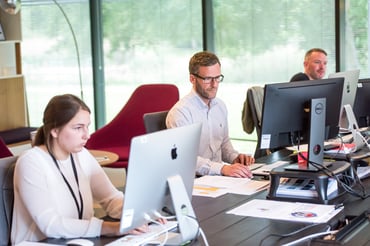The term living labs is often used interchangeably, and by many different authors, with other terms such as innovation cluster, ecosystem, community, network, test bed, or live labs. Perhaps, the authors did not realize they were doing something wrong.
Thankfully, experts like Joel West are now addressing this error. When explaining the difference between innovation networks, communities, and ecosystems, West emphasized that nuances matter. Trust the practitioners on this one!
After all, it takes very different skill sets and expertise to build and maintain an informal network compared with a government-led ecosystem with clearly defined roles and responsibilities.
To get to the core of the living lab philosophy, let’s take a deeper look. What exactly is a living lab and what makes it an exciting space for open and user-driven innovation?
What are living labs?
Living labs are open innovation networks where users, consumers, and households are systematically involved in the development of new solutions.
If you’re a space enthusiast like me, the term living lab conjures up an image of Biosphere 2 - the study designed to test whether humans could raise a self-sustaining colony, in preparation for inhabiting other planets.
But this analogy isn’t entirely correct as this facility was not a living lab for one very important reason: though clearly a collaborative endeavor, with the crew working with physical equipment and animals in the biomes and with Mission Control, not all participants were held equal.
Typically, living labs are information- and communication technology-driven innovation networks based on the philosophy of open innovation, where all users are equivalent to every other participant. Within living labs, users shape the innovation in their daily real-life environments, whereas in traditional innovation networks or labs, users are observed and their insights are captured and interpreted by experts.
The term living labs originally referred to spaces built to observe the interaction between humans and technology. Bill Mitchell, former dean of MIT's School of Architecture and Planning, and the father of the living lab concept, noted that:
“He linked tomorrow's cities to living organisms or very-large-scale robots, with nervous systems that enable them to sense changes in the needs of their inhabitants and external conditions and respond to these needs.”
Today’s living labs share these characteristics of adaptability and responsiveness.
Types of Living Labs
According to Asbjørn Følstad, who authored a comprehensive review of the origins and use of the term, living labs can be classified into three major types:
Living labs as open innovation platforms
Living labs as open innovation platforms or public-private partnerships (PPP) are usually set up by companies, public agencies, universities, institutes, or other groups of people collaborating for the creation, prototyping, validating, and testing of new services, products, and systems in a real-life context.
The European Network of Living Labs provides an excellent overview of these specialized institutions.
Living labs exposing testbed applications
These living labs are designed to expose testbed applications to users. They are delimited environments to test software and services outside of production environments, for example, in the defense industry.
Living labs to experience and experiment with ubiquitous computing
These types of living labs were established at a number of research organizations from the late 1990s onwards. A current example is Disney Research's collaboration with the Swiss Federal Institute of Technology Zürich (ETH) and Carnegie Mellon University.
The roles within living labs
Each living lab needs a range of facilitators. In "Actor roles and role patterns influencing innovation in living labs", the author includes this somewhat nuanced list:
- Coordinator - coordinates a group of participants;
- Gatekeeper - possesses resources;
- Planner - participates in the development process; provides intangible resources;
- Messenger - forwards and disseminates information in the living lab network;
- Integrator - integrates heterogeneous knowledge;
- Contributor - collaborates intensively with other actors;
- Webber - the relationship promoter or initiator;
- Advocate - distributes information externally;
- Accessory provider - promotes products, services, and expertise;
- Facilitator - offers resources for use among the living lab network;
- Informant - brings users’ understanding and knowledge to the living lab;
- Co-creator - co-designs products, services, or processes;
- Instigator - influences actors' decision-making processes;
- Producer - contributes to the development of the solution;
- Builder - promotes the emergence of close relationships;
- Orchestrator - guides and supports network activities, establishes trust;
- Tester - tests innovation in real-life environments.
What are the main processes within living labs?
As set out in the innovation management literature living labs undertake five main processes:
- Innovation initiatives management, or the core processes for accessing and involving user communities
- Technical development, focused on engineering solutions developed at the lab
- Monitoring and evaluation, for tracking the success of lab initiatives and practices
- Organizational management, including strategy management and governance, technology infrastructure management, knowledge management, and stakeholder management processes
- Deployment and operation, or processes for managing the user communities.
This type of “process reference model” sets out a formalized approach to guide user communities, research organizations, and technology providers in creating a self-sustaining living lab and enables benchmarking between different living labs, for example, to measure the degree of adoption.
Living labs case studies
The National University of Singapore Living Lab
The NUS Living Lab was born out of the National University of Singapore’s ambition to become Asia’s Stanford University.
The aim was that, by turning the University’s Kent Ridge campus into a giant “petri dish” for tech start-ups, researchers, and larger companies, the lab would facilitate the emergence of an “intelligent campus” integrating the latest technological advances to improve the quality of life of people who visit, work, study, and live there.
The ambition? The campus would serve not only as a complex test bed for innovations in applications and services at NUS, but also as a vibrant learning environment to enhance how students interact with their peers and faculty members.
Massachusetts Institute of Technology (MIT) Living Lab
The MIT Living Lab is home to some of the most well-established facilities of their kind in the world.
MIT’s goal is to conduct real-time research on subjects like mass-personalized products, mass-personalized housing, mobility-on-demand networks, and city design dynamics. The goal of the “Home Genome Project”, for example, is to establish a user-friendly online apartment design configurator.
The configurator would enable consumers to design their own interior room layouts through an intelligent search algorithm that matches their living styles to hundreds, and eventually thousands, of unique apartment layouts.
The Future Classroom Lab
The Future Classroom Lab, led and managed by European Schoolnet, is a network of 31 European government education departments. It is a living lab designed to assist its stakeholders (including Adobe, LEGO Education, Oracle Academic, and Panasonic for Education) in observing how conventional learning spaces can be redeveloped to support new styles of teaching and learning.
The African Living Lab
The African Living Lab ISEG/UNIDAF is a consortium of organizations supporting technology and know-how transfer to benefit African organizations.
The lab, which is taking an active part in the development of knowledge for urban and rural African populations, is working in a number of fields, including promoting digital communities and cities, e-learning, e-health, and telemedicine.
---
Ultimately, living labs enable meaningful connections that are not an end themselves, but rather the means to an exciting beginning.
Happy (open) innovating!










